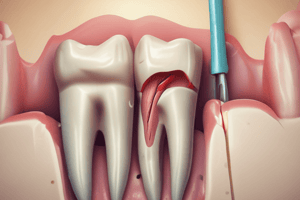Podcast
Questions and Answers
What is the first step in the crown-down or step-down technique protocol?
What is the first step in the crown-down or step-down technique protocol?
- Access preparation to remove cervical bulges (correct)
- Eliminate pulp chamber obstructions
- Explore canal with small instruments
- Introduce progressively smaller files into the canal
What is done after the coronal to mid-root enlargement using larger instruments in the protocol?
What is done after the coronal to mid-root enlargement using larger instruments in the protocol?
- Flare the coronal one third of the canal with Gates Glidden drills
- Establish final apical preparation size
- Introduce large files to coronal part of canal (correct)
- Establish working length with small instrument size
How is the working length established in the crown-down or step-down technique protocol?
How is the working length established in the crown-down or step-down technique protocol?
- By placing a large file in the canal
- Using apex locator or radiograph (correct)
- By irrigating the canals
- Using Gates-Glidden sizes 4, 3, 2
What is the purpose of irrigating during the instrumentation process?
What is the purpose of irrigating during the instrumentation process?
When is the final apical preparation size established in the protocol?
When is the final apical preparation size established in the protocol?
Which part of the canal is flared with Gates Glidden drills or rotary files of greater taper?
Which part of the canal is flared with Gates Glidden drills or rotary files of greater taper?
What determines when sequentially smaller files are introduced into the canal?
What determines when sequentially smaller files are introduced into the canal?
How is a large file (#70) placed in the canal according to the protocol?
How is a large file (#70) placed in the canal according to the protocol?
Why are Gates-Glidden sizes 4, 3, and 2 used during the protocol?
Why are Gates-Glidden sizes 4, 3, and 2 used during the protocol?
Flashcards are hidden until you start studying
Study Notes
Objectives of Root Canal Preparation
- Confine instrumentation to the root canal apex
- Avoid forcing necrotic material beyond the foramen during canal preparation
- Remove all pulp tissue, bacteria, and their by-products, debris from the root canal system
- Create sufficient space to receive intra-canal medicament and for irrigants to flow
Cleaning and Shaping of Root Canal System
- Cleaning refers to the removal of all contents of the root canal system before and during shaping
- Includes removal of:
- Organic substances
- Microflora
- Bacterial by-products
- Caries
- Pulp stones
- Dense collagen
- Previous root canal filling material
- Shaping refers to a specific cavity form with specific objectives, such as:
- Three-dimensional access into the canal
- Creating an apical preparation
- Permitting final obturation instrument and materials to fit easily
Schlider's Mechanical Objectives
- Develop a continuously tapering cone
- Make the preparation in multiple planes, introducing the concept of "flow"
- Make the canal narrower apically and widest coronally
- Avoid transportation of the foramen
- Keep the apical opening as small as possible
Clinical Objectives of Cleaning and Shaping
- Direct access should be obtained along the straight lines
- The length of the tooth should be accurately determined
- Instruments should be used in a sequence of sizes with periodic recapitulation and without skipping of the sizes
- Instruments should be used with a quarter to half turn and withdrawn with a full stroke
- Barbed broaches should be used cautiously and only when the root canal is wide enough to permit their insertion and rotation without binding
Instrumentation Techniques
- Circumferential filing: moving the file around the circumference of the canal space while stroking the instrument in a 1-3 mm amplitude
- Reaming: using a clockwise or right-hand rotation of an instrument with spiral cutting edges
- Step-back technique: refining the root canal by using a master apical file and circumferentially filing the canal walls to achieve a smooth taper
Advantages and Disadvantages of Step-Back Technique
- Advantages:
- Less likely to cause periapical trauma
- Facilitates removal of more debris
- Allows creation of a small apical preparation with larger instruments
- Facilitates packing of additional gutta percha cones
- Minimizes procedural errors
- Disadvantages:
- Significant apical extrusion of debris
- Apical blockage
- Canal deviation
- Time-consuming
- Alteration of working length
- Apical extrusion of debris during root canal instrumentation may be associated with postoperative pain or discomfort
Studying That Suits You
Use AI to generate personalized quizzes and flashcards to suit your learning preferences.




